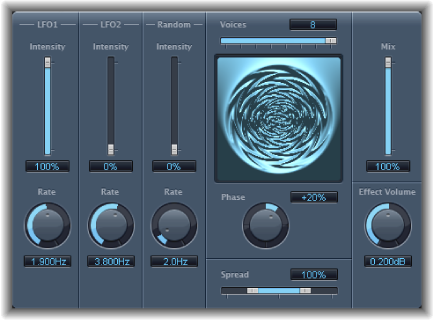Ensemble Effect
The Ensemble combines up to eight chorus effects. Two standard LFOs and one random LFO (which generates random modulations) enable you to create complex modulations. The Ensemble’s graphic display visually represents what is happening with the processed signals.
The Ensemble effect can add a great deal of richness and movement to sounds, particularly when you use a high number of voices. It is very useful for thickening parts, but it can also be used to emulate more extreme pitch variations between voices, resulting in a detuned quality to processed material.

- Phase knob and field: Controls the phase relationship between the individual voice modulations. The value you choose here is dependent on the number of voices, which is why it is shown as a percentage value rather than in degrees. The value 100 (or −100) indicates the greatest possible distance between the modulation phases of all voices.